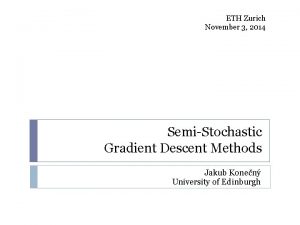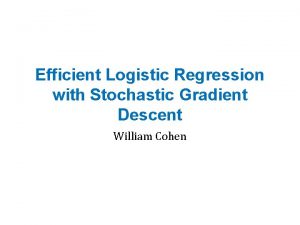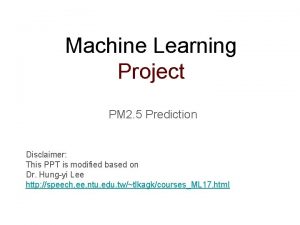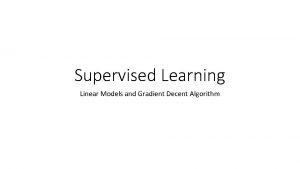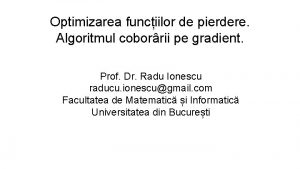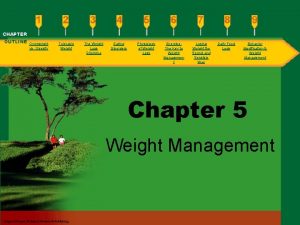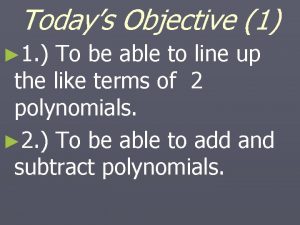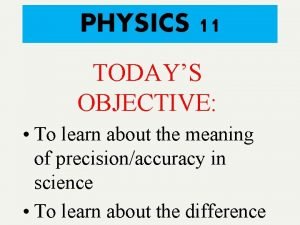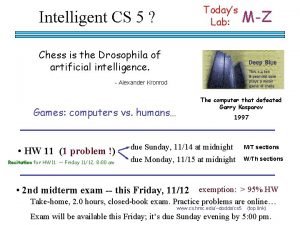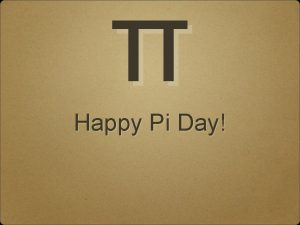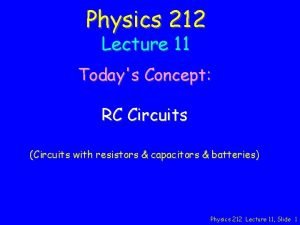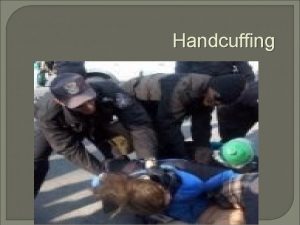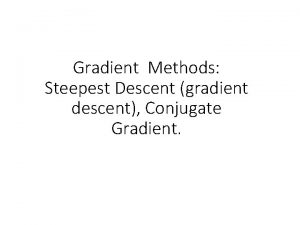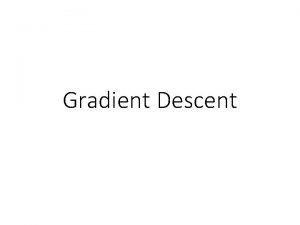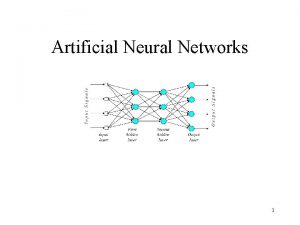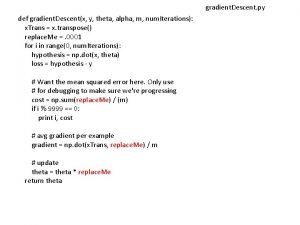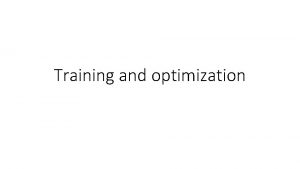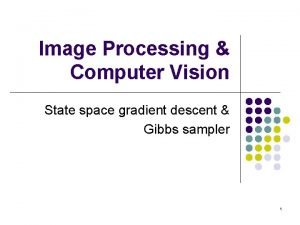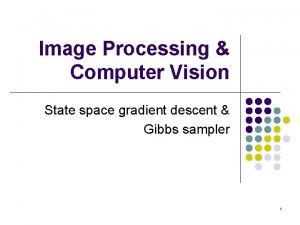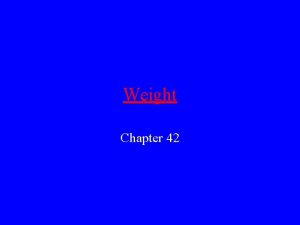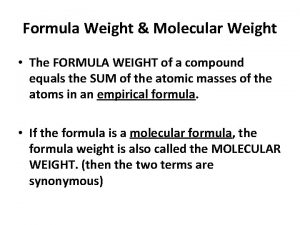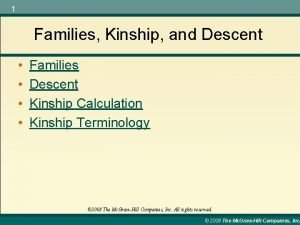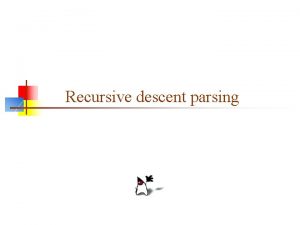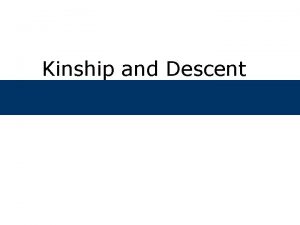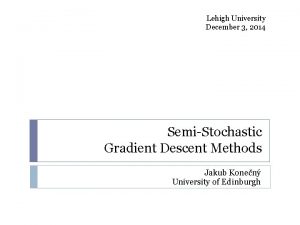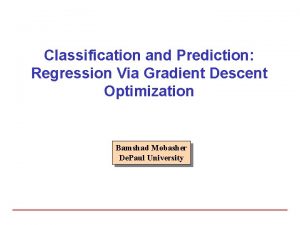Todays Topics Weight Space for ANNs Gradient Descent
























- Slides: 24

Today’s Topics • • • Weight Space (for ANNs) Gradient Descent and Local Minima Stochastic Gradient Descent Backpropagation The Need to Train the Biases and a Simple Algebraic Trick • Perceptron Training Rule and a Worked Example • Case Analysis of Delta Rule 11/10/16 cs 540 - Fall 2016 (Shavlik©), Lecture 18, Week 10 1

WARNING! Some Calculus Ahead 11/10/16 cs 540 - Fall 2016 (Shavlik©), Lecture 18, Week 10 2

No Calculus Experience? • Derivatives generalize the idea of SLOPE • How to calc the SLOPE of a line d (m x + b) dx = m // ‘mx + b’ is the algebraic form of a line // ‘m’ is the slope // ‘b’ is the y intercept (value of y when x = 0) Two (distinct) points define a line 11/10/16 cs 540 - Fall 2016 (Shavlik©), Lecture 18, Week 10 3

Weight Space • Given a neural-network layout, the weights and biases are free parameters that define a space • Each point in this Weight Space specifies a network weight space is a continuous space we search • Associated with each point is an error rate, E, over the training data • Backprop performs gradient descent in weight space 11/10/16 cs 540 - Fall 2016 (Shavlik©), Lecture 18, Week 10 4

Gradient Descent in Weight Space Total Error on Training Set ERROR with Current Wgt Settings ∂E ∂W W 1 W 2 11/10/16 New Wgt Settings cs 540 - Fall 2016 (Shavlik©), Lecture 18, Week 10 W 1 Current Wgt Settings W 2 5

Backprop Seeks LOCAL Minima (in a continuous space) Error on Train Set Note: a local min might over fit the training data, so often ‘early stopping’ used (later) 11/10/16 Weight Space cs 540 - Fall 2016 (Shavlik©), Lecture 18, Week 10 6

Local Min are Good Enough for Us! • ANNs, including Deep Networks, make accurate predictions even though we likely are only finding local min • The world could have been like this: Error on Train Set Weight Space Ie, most min poor, hard to find a good min • Note: ensembles of ANNs work well (often find different local minima) 11/10/16 cs 540 - Fall 2016 (Shavlik©), Lecture 18, Week 10 7

The Gradient-Descent Rule E(w) [ The ‘gradient’ E, w 0 E, w 1 E , w 2 …, E_ w. N ] This is a N+1 dimensional vector (ie, the ‘slope’ in weight space) Since we want to reduce errors, we want to go ‘down hill’ We’ll take a finite step in weight space: E E w = - E ( w ) ‘delta’ = the change to w 11/10/16 or wi = - E wi cs 540 - Fall 2016 (Shavlik©), Lecture 18, Week 10 W 1 W 2 w 8

‘On Line’ vs. ‘Batch’ Backprop • Technically, we should look at the error gradient for the entire training set, before taking a step in weight space (‘batch’ backprop) • However, in practice we take a step after each example (‘on-line’ backprop) – Much faster convergence (learn after each example) – Called ‘stochastic’ gradient descent – Stochastic gradient descent quite popular at Google, Facebook, Microsoft, etc due to easy parallelism 11/10/16 cs 540 - Fall 2016 (Shavlik©), Lecture 18, Week 10 9

‘On Line’ vs. ‘Batch’ BP (continued) * Note wi, BATCH wi, ON-LINE, for i > 1 E BATCH – add w vectors for every training example, then ‘move’ in weight space wex 1 wi wex 3 w E ON-LINE – ‘move’ after each example (aka, stochastic gradient descent) wex 2 wex 1 Vector from BATCH wex 3 w * Final locations in w space need not be the same for BATCH and ON-LINE 11/10/16 cs 540 - Fall 2016 (Shavlik©), Lecture 18, Week 10 10

BP Calculations (note: text uses ‘loss’ instead of ‘error’) k j i Assume one layer of hidden units (std. non-deep topology) 1. Error ½ ( Teacheri – Output i ) 2 2. = ½ (Teacheri – F ( [ Wi, j x Output j ] )2 3. = ½ (Teacheri – F ( [ Wi, j x F ( Wj, k x Output k)] ))2 Determine ∂ Error = ∂ Wi, j (use equation 2) ∂ Error ∂ Wj, k = (use equation 3) Recall 11/10/16 See text’s Section 18. 7. 4 for the specific calculations wx, y = - (∂ E / ∂ wx, y ) cs 540 - Fall 2016 (Shavlik©), Lecture 18, Week 10 11

Note: Differentiating RLU’s easy! Differentiating the Logistic Function (‘soft’ step-function) (use F’ = 0 when input = bias) out i = 1 F(wgt’ed in) - ( wj, i x outj - i ) 1+e 1/2 F '(wgt’ed in) = out i ( 1 - out i ) Wj x outj F '(wgt’ed in) 1/4 Notice that even if totally wrong, no (or very little) change in weights 11/10/16 cs 540 - Fall 2016 (Shavlik©), Lecture 18, Week 10 wgt’ed input 12

Gradient Descent for the Perceptron (for the simple case of linear output units) 2 Error ½ ( T – o ) ∂E ∂ Wk 11/10/16 Network’s output Teacher’s answer (a constant wrt the weights) = (T – o) ∂ (T – o) = - (T – o) ∂ o ∂ Wk cs 540 - Fall 2016 (Shavlik©), Lecture 18, Week 10 13

Continuation of Derivation ∂E ∂ Wk = - (T – o) ∂( ∑ w j x j) ∂ Wk = - (T – o) x k So Stick in formula for output ΔWk = η (T – o) xk Recall ΔWk - η ∂ Wk The Perceptron Rule We’ll use for both LINEAR and STEP-FUNCTION activation 11/10/16 ∂E cs 540 - Fall 2016 (Shavlik©), Lecture 18, Week 10 Also known as the delta rule and other names (with some variation in the calculation) 14

Node Biases Recall: A node’s output is weighted function of its inputs and a ‘bias’ term Output 1 bias Input These biases also need to be learned! 11/10/16 cs 540 - Fall 2016 (Shavlik©), Lecture 18, Week 10 15

Training Biases ( Θ’s ) A node’s output (assume ‘step function’ for simplicity) 1 if W 1 X 1 + W 2 X 2 +…+ Wn Xn ≥ Θ 0 otherwise Rewriting W 1 X 1 + W 2 X 2 + … + W n Xn – Θ ≥ 0 W 1 X 1 + W 2 X 2 + … + Wn Xn + Θ (-1) ≥ 0 ‘activation’ weight 11/10/16 cs 540 - Fall 2016 (Shavlik©), Lecture 18, Week 10 16

Training Biases (cont. ) Hence, add another unit whose activation is always -1 The bias is then just another weight! Eg Θ -1 11/10/16 cs 540 - Fall 2016 (Shavlik©), Lecture 18, Week 10 Θ 17

Perceptron Example (assume step function and use η = 0. 1) Train Set X 1 X 2 Correct Output 3 -2 1 6 1 0 5 -3 1 X 2 -1 11/10/16 1 -3 Perceptron Learning Rule ΔWk = η (T – o) xk Out = Step. Function(3 1 - 2 (-3) - 1 2) =1 2 No wgt changes, since correct cs 540 - Fall 2016 (Shavlik©), Lecture 18, Week 10 18

Perceptron Example (assume step function and use η = 0. 1) Train Set X 1 X 2 Correct Output 3 -2 1 6 1 0 5 -3 1 X 2 -1 11/10/16 1 Perceptron Learning Rule ΔWa = η (T – o) xa Out = Step. Function(6 1 + 1 (-3) - 1 2) = 1 // So need to update weights -3 2 cs 540 - Fall 2016 (Shavlik©), Lecture 18, Week 10 19

Perceptron Example (assume step function and use η = 0. 1) Train Set X 1 X 2 Correct Output 3 -2 1 6 1 0 5 -3 1 X 2 Perceptron Learning Rule ΔWk = η (T – o) xk 1 - 0. 1 6 = 0. 4 Out = Step. Function(6 1 + 1 (-3) - 1 2) =1 -3 -0. 1 1 = -3. 1 -1 2 - 0. 1 (-1) = 2. 1 11/10/16 cs 540 - Fall 2016 (Shavlik©), Lecture 18, Week 10 20

Pushing the Weights and Bias in the Correct Direction when Wrong Output Assume TEACHER=1 and ANN=0, so some combo of (a) wgts on some positively valued inputs too small (b) wgts on some negatively valued inputs too large (c) ‘bias’ too large Opposite movement when TEACHER= 0 and ANN = 1 Wgt’ed Sum bias 11/10/16 cs 540 - Fall 2016 (Shavlik©), Lecture 18, Week 10 21

Case Analysis: ΔWk = η (T – o) xk Assume Teach = 1, out = 0, η = 1 Note: ‘bigger’ means closer to +infinity and ‘smaller’ means closer to -infinity Input Vector: Weights: New Wgts: Four Cases Pos/Neg Input Pos/Neg Weight Cases for the BIAS 1, -1, 1, -1 2, -4, -3, 5 2+1, -4 -1, -3+1, 5 -1 bigger smaller Old vs New Input Wgt 2 vs 3 smaller 4 vs 5 -3 vs -2 -5 vs -4 So weighted sum will be LARGER (-2 vs 2) 11/10/16 ‘-1’ 6 or -6 // the BIAS 6 -1 -6 -1 And BIAS will be SMALLER cs 540 - Fall 2016 (Shavlik©), Lecture 18, Week 10 22

HW 4 • Train a perceptron on WINE – For N Boolean-valued features, have N+1 input units (+1 due to “-1” input) and 1 output unit – Learned model rep’ed by vector of N+1 doubles – Your code should handle any dataset that meets HW 0 spec • (Maybe also train an ANN with 100 HU’s - but not required) • Employ ‘early stopping’ (later) • Compare perceptron testset results to random forests 11/10/16 cs 540 - Fall 2016 (Shavlik©), Lecture 18, Week 10 23

Wrapup of Basics of ANN Training ∂ Error ∂ Wk • We differentiate (in the calculus sense) all the free parameters in an ANN with a fixed structure (‘topology’) – If all else is held constant (‘partial derivatives’), what is the impact of changing weightk? – Simultaneously move each weight a small amount in the direction that reduces error – Process example-by-example, many times • Seeks local minimum, ie, where all derivatives = 0 11/10/16 cs 540 - Fall 2016 (Shavlik©), Lecture 18, Week 10 24
 St.anns college chirala materials
St.anns college chirala materials Gradient descent rule
Gradient descent rule Linear regression with multiple features
Linear regression with multiple features Gradient descent
Gradient descent Gradient descent java
Gradient descent java Kay ousterhout
Kay ousterhout Linear regression gradient descent
Linear regression gradient descent Gradient descent python implementation
Gradient descent python implementation Gradient descent equation
Gradient descent equation Batch gradient descent
Batch gradient descent Wrestling weight descent calculator
Wrestling weight descent calculator Tolerable weight is a body weight
Tolerable weight is a body weight Bulk gaining industries
Bulk gaining industries Wat is todays date
Wat is todays date Todays objective
Todays objective Todays objective
Todays objective Todays lab
Todays lab Todays plan
Todays plan Todays concept
Todays concept Todays goal
Todays goal Safe online talk
Safe online talk Todays jeopardy
Todays jeopardy Todays generations
Todays generations Todays objective
Todays objective Todays health
Todays health

